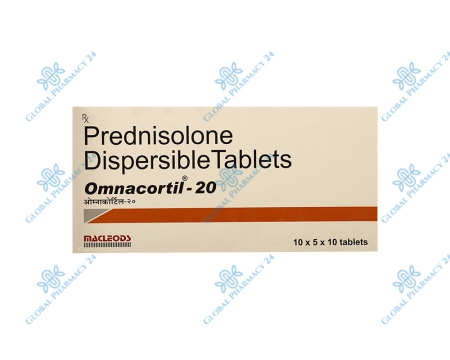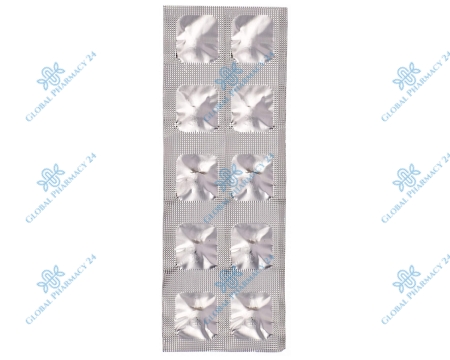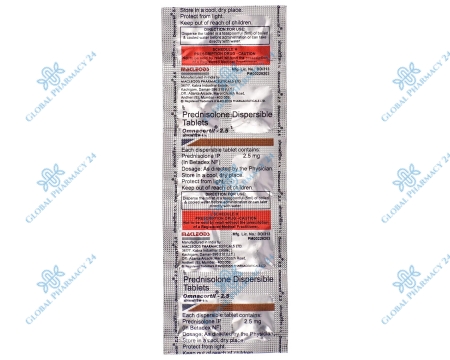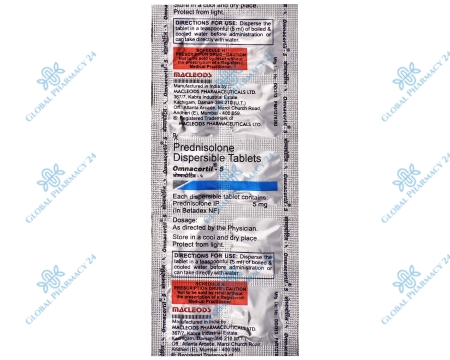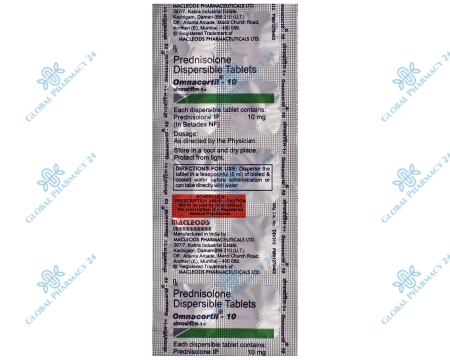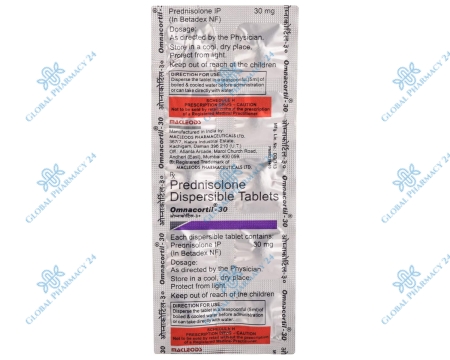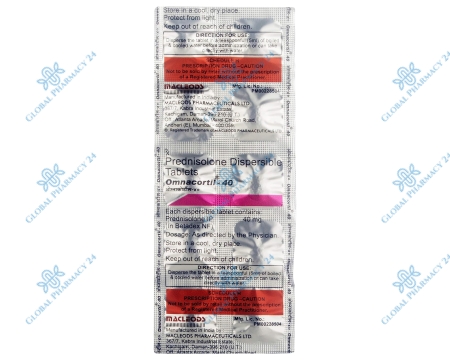| Characteristic | Detail |
|---|---|
| Active Ingredient | Prednisolone |
| Available Dosages | 5mg, 20mg |
| Indications | Anti-inflammatory, Immunosuppression, Allergic Reactions |
| Administration Form | Oral |
| Duration of Effect | Depends on the condition being treated, dosage, and individual response |
| Side Effects | Weight gain, Increased appetite, High blood pressure, Mood changes |
Understanding Omnacortil
Omnacortil is a versatile medication widely used in the treatment of various inflammatory and autoimmune conditions. Its active ingredient, prednisolone, is a potent glucocorticoid with powerful anti-inflammatory and immunosuppressive properties. This medication is essential in managing conditions such as arthritis, asthma, allergies, and autoimmune diseases, providing relief and improving the quality of life for many patients.
Prednisolone, the core component of Omnacortil, works by mimicking the effects of cortisol, a natural hormone produced by the adrenal glands. It significantly reduces inflammation and suppresses the immune system's activity, making it highly effective in treating inflammatory conditions and autoimmunity. However, its use requires careful dosage management and monitoring to balance effectiveness with potential side effects.
An Overview of Omnacortil
Omnacortil is recognized for its effectiveness in providing rapid relief from inflammation and allergic reactions. By inhibiting the release of substances that trigger inflammation and immune responses, it offers a broad therapeutic application, ranging from short-term interventions in acute conditions to long-term management of chronic diseases.
The Active Ingredient: Prednisolone
Prednisolone is the powerhouse behind Omnacortil's effectiveness. As a synthetic corticosteroid, it closely resembles cortisol, assisting in regulating metabolism, the immune system, and the body's response to stress. Its adaptability in treating a wide array of conditions makes it a staple in medical treatments.
The Impact of Prednisolone on Canine Health
In veterinary medicine, prednisolone is used extensively to treat inflammatory and autoimmune conditions in dogs. Its ability to significantly reduce inflammation and suppress the immune system's response is crucial in managing conditions like allergies, arthritis, and certain autoimmune diseases, enhancing the welfare of canine patients.
Dosages: 5mg and 20mg
Omnacortil is available in two dosage strengths: 5mg and 20mg, catering to the varying needs of patients. The selection of the appropriate dosage is critical and depends on the specific condition being treated, the severity of symptoms, and the patient's overall health profile. Lower doses are generally used for mild conditions, while higher doses may be necessary for more severe cases.
Choosing the right dosage of Omnacortil involves a careful evaluation of the therapeutic goals and potential side effects. Physicians often start with the lowest effective dose and adjust based on the patient's response to treatment. This approach minimizes the risk of side effects while ensuring the medication's efficacy.
Choosing the Right Dosage
Deciding between the 5mg and 20mg dosages of Omnacortil is a critical decision that must be made by a healthcare professional. This choice is influenced by the patient's medical history, the nature and severity of the condition, and the desired therapeutic outcome.
Cases When 5mg is Ideal
The 5mg dosage of Omnacortil is typically prescribed for managing mild to moderate conditions or as part of a tapering strategy when reducing the dosage. It's ideal for patients who require a lower dose to minimize side effects while effectively managing their condition.
Instances When 20mg is Appropriate
The 20mg dosage is reserved for more severe conditions or cases where an aggressive treatment approach is necessary. This higher dosage is often used in short-term interventions to quickly reduce severe inflammation or immune activity.
How to Administer Omnacortil
Administering Omnacortil correctly is paramount to achieving the desired therapeutic effects while minimizing potential side effects. It is usually taken orally, with or without food, according to the prescribing physician's instructions. The timing, frequency, and duration of administration are tailored to the individual's needs, the condition being treated, and the response to therapy.
Understanding the nuances of Omnacortil administration is crucial for both healthcare providers and patients. Proper administration not only enhances the medication's effectiveness but also plays a significant role in patient safety and the overall success of the treatment plan.
Dosage Guidelines for Different Conditions
Dosage guidelines for Omnacortil vary widely depending on the condition being treated. Physicians will determine the appropriate dosage and administration schedule based on the severity of the condition, patient's response to treatment, and any underlying health issues.
Administration for Anti-Inflammatory Purposes
For anti-inflammatory purposes, Omnacortil is administered in a dose that effectively reduces inflammation without causing significant side effects. The dosage may be adjusted based on the patient's response and the condition's progression.
Administering for Immunosuppression
In cases requiring immunosuppression, Omnacortil is used at doses that sufficiently suppress the immune system to treat autoimmune conditions or prevent organ transplant rejection. The balance between efficacy and the risk of infection is carefully managed.
Administration for Other Medical Conditions
Omnacortil's versatility extends to treating a variety of other medical conditions, including allergic reactions, asthma, and certain types of cancer. Each condition requires a specific dosing regimen optimized for the best outcomes.
Possible Side Effects of Omnacortil
Omnacortil, like all medications, can cause side effects, although not everyone experiences them. Common side effects include weight gain, increased appetite, high blood pressure, and mood changes. These effects are generally more pronounced with higher doses and longer treatment durations.
Precautions While Using Omnacortil
When using Omnacortil, it's important to take certain precautions to ensure safe and effective treatment. Patients should inform their healthcare provider of any existing medical conditions, allergies, and medications they are taking to avoid potential interactions. Regular monitoring by a healthcare professional is essential to adjust the dosage as needed and to monitor for side effects.
Long-term use of Omnacortil requires careful consideration due to the potential for side effects such as osteoporosis, adrenal suppression, and increased risk of infection. Patients should follow their healthcare provider's instructions closely, including guidelines for gradually decreasing the dosage to avoid withdrawal symptoms.
- Pros of Omnacortil:
- Effective in reducing inflammation and suppressing the immune system.
- Can rapidly improve symptoms of a wide range of conditions.
- Available in multiple dosages for tailored treatment.
- Cons of Omnacortil:
- Potential for significant side effects with long-term use.
- Requires careful monitoring and dosage adjustments.
- May interact with other medications and exacerbate certain medical conditions.
In conclusion, Omnacortil is a highly effective medication for treating a variety of inflammatory and autoimmune conditions. Understanding its proper use, potential side effects, and necessary precautions is essential for maximizing its benefits while minimizing risks. By working closely with healthcare providers, patients can effectively manage their conditions with Omnacortil, leading to improved health outcomes.
FAQs Omnacortil
What is Omnacortil used for?
Omnacortil is a corticosteroid medication used to treat a variety of conditions such as allergic disorders, skin conditions, ulcerative colitis, arthritis, lupus, psoriasis, and breathing disorders.
How does Omnacortil work?
Omnacortil works by reducing inflammation and suppressing the immune system's response. It mimics the action of naturally occurring corticosteroid hormones in the body.
What are the common side effects of Omnacortil?
Common side effects of Omnacortil include weight gain, increased appetite, mood changes, insomnia, acne, thinning skin, easy bruising, and increased sweating. However, not everyone experiences these side effects, and their severity can vary.
Can Omnacortil be used during pregnancy?
It's important to consult with a healthcare professional before using Omnacortil during pregnancy, as it may pose risks to the fetus. Your doctor will weigh the potential benefits against the potential risks before prescribing Omnacortil during pregnancy.
How should Omnacortil be taken?
Omnacortil should be taken exactly as prescribed by a healthcare professional. It's typically taken orally, with or without food. Do not suddenly stop taking Omnacortil without consulting your doctor, as it may lead to withdrawal symptoms.
Can Omnacortil interact with other medications?
Yes, Omnacortil can interact with other medications. It's important to inform your doctor about all the medications, supplements, and herbal products you are taking before starting Omnacortil to avoid potential interactions.


